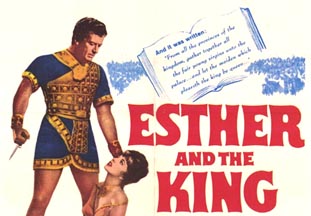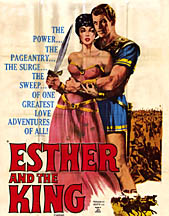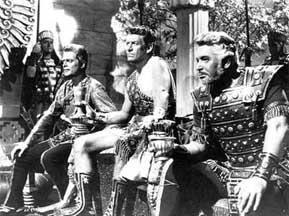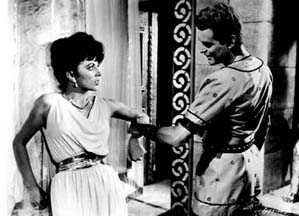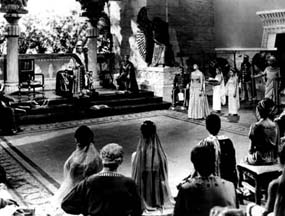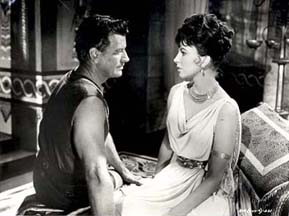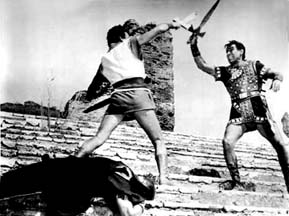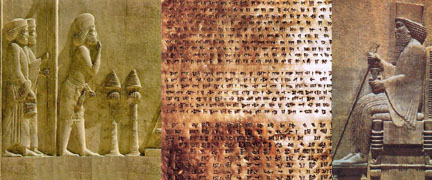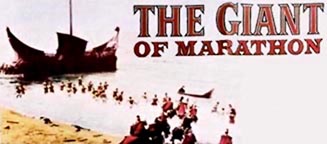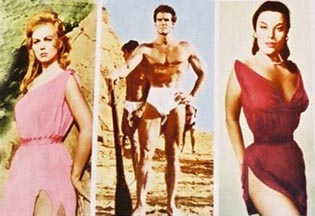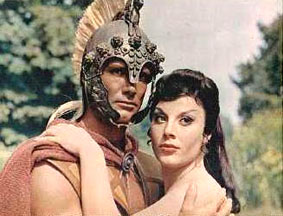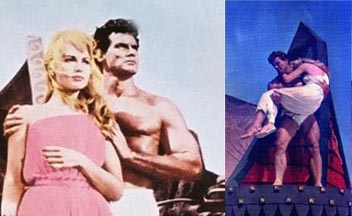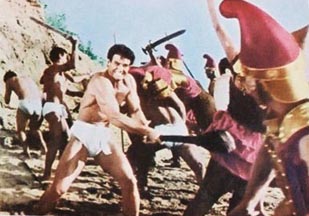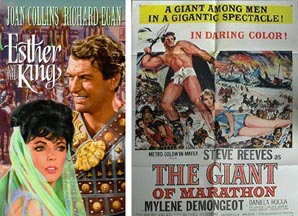  
|
|
By Darius Kadivar The past is a foreign country, people do things differently there ... In the 1950's and 1960's the overgrowing popularity of television forced American
cinema to make films only fit for the big screen. Often shot in Cinemascope and through
co-production with European firms like the famous Cinnecita Studios in Rome, Hollywood
was to focus attention on historical epics or stories inspired by the Bible. Some
of these films made Hollywood history, like Cecile
B. De Mille's 1956 remake The
Ten Commandmants or William
Wyler's 1959 remake Ben
Hur which won 11 Oscars and both starred Charlton
Heston -- a record only equal1ed by James Cameron's 1998 epic, Titanic. Raoul Walsh's
1960 epic Esther
and the King and French Hollywood expatriate Jacques Tourneur's The Giant of Marathon (1959) are
two such films that deserve to be mentioned for they involve two historical events
related to ancient Persia (also see: Persia?):
Esther
and the King Esther and the King tells the Biblical love story between Esther (Hadas'sah) and the Persian King Ahasuerus (Xerxes 1st : 520 - 465 BC). In this 1960 film, Richard Egan plays King Ahasuerus and Joan Collins plays the Esther the Jewish slave who becomes Queen of Persia. Ironically the same Richard Egan two years later will play the role of Leonidas the Spartan hero who bravely opposed King Xerxes at Thermoplae in Rudolph Maté's The 300 Spartans / Lion of Sparta (see: Battle for the West). When Vashti (Daniella Rocca), the chief wife of Ahasuerus, displeases him, with
a grotesque dance during a banquet, the king puts her aside and decides to choose
a new wife from among the beauties of the kingdom. Just about to be married to her
soldier fiance, back from the Egyptian wars with Ahasuerus, Esther a Jewish slave
is carried off to be part of the beauty contest for Persia's new queen. Ahasuerus'
choice falls on Esther. Thanks to Esther's intercession and with the help of Mordecai (Denis O'Dea) the chief eunuch (actually according to the Bible her cousin and foster father) the Jews are able to defend themselves and destroy their enemies. Haman defeated, Mordecai becomes the king's new advisor for proving his loyalty and for having saved the king's life. Victory is celebrated and as the Persian king and Esther seal their love. King Ahasuerus/Xerxes (Richard Egan), center, and his This film has the rare quality of being based on some historical research. The story is quite faithful to the Biblical account and even if Richard Egan appears Fair-haired and clean-shaven for a Persian monarch, the costumes and decors in this film are clearly faithful or at least inspired by to those of ancient Persia.
Amidst Lust at the palace of Susa
And intrigue at the Persian court ... Esther (Joan Collins) tries to conquer
Larger image As for Joan Collins, who earned stardom as a sex icon in an earlier swords-and-sandals film The Land of the Pharaohs directed by Howard Hawks, her beauty and innocence are simply captivating as her love for the king grows. She delivers one of her best performances. The rescue of the Jews by Esther is depicted in the Book of Esther in the Old Testament of the Bible and it is celebrated by Jews every year as the Feast of Purim.
Intrigue to topple the kingdom
Xerxes sides with the Jewish cause
Esther is crowned Queen of Persia The period of the Greek history Between 492 - 479 BC is marked by the Persian Wars.
It was a period of contest between the city-states of Greece and the mighty Persian
Empire. The cause of the Persian Wars was the expansion policy of the Persians. It
was impossible for latter to expand further east (to India), or beyond Egypt (due
to the Libyan desert) or towards the inhospitable land of the Scythes (north). So
their only choice was to advance west, to the European Continent. Greece was the
primary barrier and Athens was the most decisive opponent in Greece. Bas relief Apadana Palace, Persepolis: King Darius, father of Ahasuerus (Xerxes 1st), upon learning that some obscure
city-states from mainland Greece had sent help to the rebels, asked "What
sort of thing is the city of Athens?" When briefed about those insolent Athenians,
Darius became so angry that he fired an arrow skywards and vowed to punishment. His
anger was such that every night at dinner, he had a servant repeat to him "Lord,
don't forget the Athenians!" In that way the Athenians gave the Great
King the pretext he needed to invade Greece and clear the road to Europe. Larger image The Giant of Marathon (La Battaglia di Maratona) (1959) directed by Jacques Tourneur in 1959 is a US-Italian productio about Phillipides (Steve Reeves), an Athenian Olympic champion who is made captain of the Guards in Athens - but then is forced to rally the Spartans to fight the mighty Persian army led by Darius the Great (Daniele Vargas). A triangle of love and hate: This film teamed macho screen legend Steve Reeves with a fine director Jacques Tourneur and one of the best directors of photography in Italian history - Mario Bava. The combination makes for a beautifully-shot, colourful and well paced movie, which is a bit slow to start off but soon comes into its own with imaginative battle sequences and a story which is always moving. A clean-shaven Reeves plays Phillipides, an Olympic legend who is a hit with all the ladies - and who finds himself torn between a forbidden beauty, Andromeda (Mylène Demongeot), and Karis (Daniella Rocca), a woman made to seduce him only to deliver him to his enemies.
Phillipides (Steve Reeves) has to choose These romantic subplots are what make up the first half of the film, interspersed with plenty of dancing, a few fights here and there and lots of sweeping spectacles thanks to Bava, who really gives the film an expensive-looking veneer. The second half of the movie concerns the invasion by the Persians, with Phillipides attempting to rally the Spartans to his cause. There's an excellently-shot hand-to-hand combat scene involving an emissary who is attacked by a gang of cut-throats, who outnumber him 5-to-1 but still end up getting beaten. Andromeda (Mylene Demongeot) captive of the Then the film culminates in a fine sea battle in which Olympic heroes chuck burning spears at the approaching enemy ship, which retaliates by crushing their own ship with an awkward pair of pincers! At this point, there's also some great underwater photography and lots of violence as underwater attackers are shot and speared by the enemy. Phillipides (Steve Reeves) singlehandedly Finally, a battle ensues -- you can guess the outcome. Historically Phillipides died in his titanic effort. But the marathon became one of the most popular Olympic competitions. The film prefers to drop this historic fact and chooses instead to match him with a sexy Greek girl Andromeda (Mylene Demongeot). Philippides appears thus as a Rambo-type character defeating the mighty Persian Army single handedly. Reeves is as good as ever as the invincible masculine hero, and here he's supported by a strong cast which offers some good female characters. Tourneur's direction is assured and Bava's camerawork gives the film fine visual splendour which makes The Giant of Marathon a fine piece of solid entertainment especially for its action scenes.
From Film to swords-and-sandals cult status In conclusion it could be said that although greatly romantized, Esther and the King and The Giant of Marathon offer entertaining glimpses into two major historical events that have contributed in shaping history. Notes Remakes and Co-Productions This was cost effective for Hollywood thanks to cheaper labour and less union
strikes. Today Hollywood and European Film companies have found a new haven in Morroco
and Tunisia for major films requiring great reconstructions. Swords and Sandals"
Films like Ridley Scott's Gladiator,
the lastest French epic parody Asterix
& Obelix : Mission Cleopatra have all been shot in studios in Casablanca
or Tunis. Other projects on Alexander seem to inspire Hollywood directors. After Martin Scorsese who gave up, and has already cast Leonardo Di Caprio in his latest film "The Gangs of New York, Oliver Stone (Platoon, Wall Street, JFK) has been battling for the past five years on a film on the macedonian conqueror and wants to cast Irish with actors Collin Farrel, Heath Ledger, and Matthew McConaughey in what appears as a competition for the title role, and with Chris McQuarrie's script (The Usual Suspects) read review of Alexander Script. Italian producer and huband to Sophia Loren, Dino De Laurentis, also wants to
produce an Alexander film to be directed by Ridley Scott (Gladiator), has
a very different casting approach. "I would like to have big stars in the secondary
roles," he says, "but I would get an unknown for the part of Alexander
- a unique human being." The Gates of Fire, a remake of the 300 Spartans based on the novel of Steven Pressfield, is to be directed by Michael Mann (Heat, Ali) with George Clooney (Oceans Eleven, Solaris) as producer and Bruce Willis (Die Hard, Armageddon) is said to be interested in playing the title role. Who will be cast in the role of King Xerxes is still unknown, and no production date has been announced yet. Read review of Gates of Fire Script. Dreamworks will be releasing in this coming July 2003 an animated cartoon, Sinbad: Legend of the Seven Seas. Does this article have spelling or other mistakes? Tell me to fix it.
|
|
Web design by Bcubed
Internet server Global Publishing Group


































